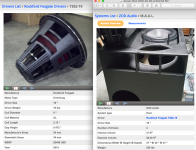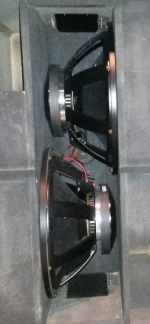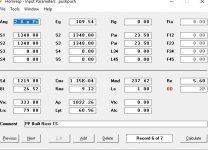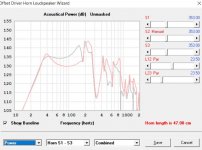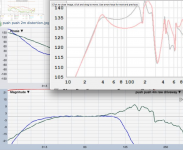Aside from vent and suspension noise in testing when playing test tones did you ever hear those noises when usjng the speakers for normal material?
No, I doubt it could be heard with music, unless the music has very disproportionate content 25-30 Hz ish...
Why are these tests showing the fundamental response being RULER FLAT ?
REW's Distortion control button.... Plot normalized to fundamental is on.
Makes it easier to assess distortion across the spectrum without accounting for fundamental SPL variation, (which as you can see in the raw mag trace, wasn't much.)
Mark,Been listening to the double 18" PPSL for a week or so, both in push-pull configuration, and also turning the inverted driver around into a push-push clamshell.<snip>
Interesting results!
Appears that the BMS 18N862 speaker design using triple shorting rings is not only very low distortion, but also has a very linear suspension and motor in terms of deviation between "push" and "pull".
The even order differences between the "push" and "pull" stroke are cancelled in PP mounting, but lacking that difference, either way of mounting works basically the same, with the exception of the suspension and coil vent noise more audible with a "reversed" driver.
In other words, "if it ain't broke, don't try to fix it" :^).
Klippel analyzer data has really upped the game for the speaker manufacturing companies using it, and those others that closely copy the subsequent improvements. Lots of advancement in woofer design in the last couple decades!
If the push-push drivers are rear mounted (requiring a rear access panel) the plenum volume can be made much smaller than a push pull. The smaller volume raises the plenum's "pipe resonance" peak frequency and reduces the level of the peak.
Art
Last edited:
Thx Art !
Everything you have forecast has come to pass 🙂
And I keep thinking about going vertical with push-push to avoid sag.
But still trying to minimize width.
The drivers are 10" deep. 3/4"baffles and 5/8" sides add to 2 3/4".
So I'm 22 3/4 wide before any breathing room, anywhere.
For this driver, what would recommend as a safe minimum for:
-plenum inside width ?
- and clearance between back of motor and side walls?
I'll add those numbers to 22 3/4 and see if a new build is in play ...
Everything you have forecast has come to pass 🙂
And I keep thinking about going vertical with push-push to avoid sag.
But still trying to minimize width.
The drivers are 10" deep. 3/4"baffles and 5/8" sides add to 2 3/4".
So I'm 22 3/4 wide before any breathing room, anywhere.
For this driver, what would recommend as a safe minimum for:
-plenum inside width ?
- and clearance between back of motor and side walls?
I'll add those numbers to 22 3/4 and see if a new build is in play ...
1) I prefer maximizing width while maintaining enough depth for stability, the larger the frontal area, the more forward gain.1).. I keep thinking about going vertical with push-push to avoid sag.
But still trying to minimize width.
2) The drivers are 10" deep. 3/4"baffles and 5/8" sides add to 2 3/4".
So I'm 22 3/4 wide before any breathing room, anywhere.
3)For this driver, what would recommend as a safe minimum for:
-plenum inside width ?
4)- and clearance between back of motor and side walls?
I'll add those numbers to 22 3/4 and see if a new build is in play ...
2)There is no reason the drivers have to share a plenum. The drivers could be vertically arranged, each with an individual plenum made by the side wall and it's baffle.
A vertical arrangement could be made even thinner than your present "too skinny" (for the Golden Ratio😉 )cabinet.
3)I don't see any Xlim spec for the BMS18N862, but assuming it's like others of it's general appearance, Xlim would be around double Xmax, about 38mm.
The surround could extend about 18mm past the 3/4" baffle at Xlim, so that would be the absolute minimum. I think 38 mm would be plenty.
Easy enough to test by jamming some scrap between your drivers.
4)At least half the width of the driver's vent hole.
As an example of a huge excursion driver (34mmm Xmax!) with very little space in a plenum, look at Josh Ricci's M.A.U.L with the installation cover removed. The inner driver does not have much more distance to the wall than Xlim from what it appears, and the quad cabinet comes in with very low distortion.
Attachments
Last edited:
Aside from vent and suspension noise in testing when playing test tones did you ever hear those noises when usjng the speakers for normal material?
I had 862's on dipole and played louder there was noise from pole vent around 80hz, that might show on mark100 push-pull graph. Risen 3rd
1) I prefer maximizing width while maintaining enough depth for stability, the larger the frontal area, the more forward gain.
2)There is no reason the drivers have to share a plenum. The drivers could be vertically arranged, each with an individual plenum made by the side wall and it's baffle.
A vertical arrangement could be made even thinner than your present "too skinny" (for the Golden Ratio😉 )cabinet.
3)I don't see any Xlim spec for the BMS18N862, but assuming it's like others of it's general appearance, Xlim would be around double Xmax, about 38mm.
The surround could extend about 18mm past the 3/4" baffle at Xlim, so that would be the absolute minimum. I think 38 mm would be plenty.
Easy enough to test by jamming some scrap between your drivers.
4)At least half the width of the driver's vent hole.
As an example of a huge excursion driver (34mmm Xmax!) with very little space in a plenum, look at Josh Ricci's M.A.U.L with the installation cover removed. The inner driver does not have much more distance to the wall than Xlim from what it appears, and the quad cabinet comes in with very low distortion.
Ongoing thanks Art !
1) good point about forward gain.
My concern with width stems from anticipating the need for multiple subs, and getting too wide. But the more i think about it, going past 2 boxes a side is getting too inefficient... time to bring out horn boxes.
So time to mull greater width.
2) do you think staggering would provide close to the same vibration reduction, as directly opposed?
3 & 4) perfect, thx
1) Each doubling of cabinets brings efficiency up 3 dB.
That said, if I owned Orbit Shifters, I wouldn't be messing around with the BMS 2x18" ;^).
2) Close, but not quite. There would be some diagonal torsion force due to the offset, but that force would be very slight compared to two drivers jack-hammering forward and back.
With the thin Neo magnet structure of your BMS drivers, you should be able to get the spacing tighter than the example below:
That said, if I owned Orbit Shifters, I wouldn't be messing around with the BMS 2x18" ;^).
2) Close, but not quite. There would be some diagonal torsion force due to the offset, but that force would be very slight compared to two drivers jack-hammering forward and back.
With the thin Neo magnet structure of your BMS drivers, you should be able to get the spacing tighter than the example below:
Attachments
So today, I put my push-push side by side with an Orbit Shifter, as a bit of a final test.
Art, I have to say, it's a pretty easy decision... the BMS push-push(PP) wins for me....
They both have the same sensitivity, when x-over and peak flattening are in place.
They both take the same power....same 3 kW, 4 ohm, amp requirement. Maybe the PP can take a little more power, program is 6000w.
The OS uses only one driver...advantage OS.
They both weigh about the same. Maybe the OS is 10-15lb lighter, not sure. No real difference in handling.
The OS is a little smaller, which is always better.
The PP has substantially smoother raw mag and phase response.
The PP goes lower.
The clincher, the PP simply sounds cleaner, more detailed.
Between this sub, and the the modular mains I posted on soundforums....
well my 3tx /OS rig is about to hit the marketplace ! Yea DIY 😀
Art, I have to say, it's a pretty easy decision... the BMS push-push(PP) wins for me....
They both have the same sensitivity, when x-over and peak flattening are in place.
They both take the same power....same 3 kW, 4 ohm, amp requirement. Maybe the PP can take a little more power, program is 6000w.
The OS uses only one driver...advantage OS.
They both weigh about the same. Maybe the OS is 10-15lb lighter, not sure. No real difference in handling.
The OS is a little smaller, which is always better.
The PP has substantially smoother raw mag and phase response.
The PP goes lower.
The clincher, the PP simply sounds cleaner, more detailed.
Between this sub, and the the modular mains I posted on soundforums....
well my 3tx /OS rig is about to hit the marketplace ! Yea DIY 😀
Thanks for the info Mark. Makes me a bit more excited about my dual 15N850 live instrument monitor.

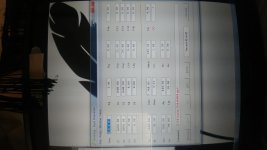
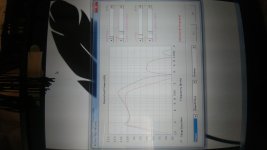
These are the inputs and outputs for a pair of 18 sounds 21MLW4000 subs in a PPSL I sussed out.
Can it be this simple and have that good a bandwidth?
Am I missing something?
It's a monster of a box but I've got the room and the drivers are inexpensive on Amazon.
I put in a highpass to control excursion below tuning. Lowpass will be per taste in place at 12db/oct.
Your input screen shows "OD" (Offset Driver) with only one driver, PP requires two, so you are missing something ;^).Am I missing something?
Thanks for the info Mark. Makes me a bit more excited about my dual 15N850 live instrument monitor.
Cool Ernie, good luck !
An entire driver! Wow! Hmm...now where did i leave that 21" subwoofer....i just had thr damn thi g too!
Question. What would happen if you placed the vent within the plenum?
That question keeps coming up.
I'm not the expert here, but evidently, doing this would require the plenum to be so large, that you'd lose a lot of the benefit of having a plenum in the first place.
I'm not sure why anyone would want a sub to go higher than about 120 Hz, but evidently some do, and a small plenum (someone correct me if I'm wrong) adds reinforcement at higher frequencies. In other words, you get a more extended top end without corrective EQ.
I think. 😱
1) The plenum could be used for a bass-reflex port, but would require figuring out the effect of the volume of the driver(s) within it on Fb.1)That question keeps coming up.
I'm not the expert here, but evidently, doing this would require the plenum to be so large, that you'd lose a lot of the benefit of having a plenum in the first place.
2)I'm not sure why anyone would want a sub to go higher than about 120 Hz, but evidently some do, and a small plenum (someone correct me if I'm wrong) adds reinforcement at higher frequencies. In other words, you get a more extended top end without corrective EQ.
With a pair of high excursion drivers in a small plenum/port, the Fb would actually change slightly down and up with the reduction of volume in the port area on the + compared to the - stroke.
Many commercial cabinets share a plenum with a port, the EAW SB1000 being a very popular example.
2) A small plenum adds a smaller peak in the upper response, a large plenum makes a larger peak, typically in the 120 Hz range, not "higher frequencies".
Most would choose to use corrective EQ to remove the peak- I certainly did with my PPSL cabinets.
Art
1) The plenum could be used for a bass-reflex port, but would require figuring out the effect of the volume of the driver(s) within it on Fb.
If I was going to build this thing, I'd model it as a TH with a large rear chamber (represent the cabinet volume) and S1-S4 representing the vent. I'd also model 1/2 of the box (one driver) firing into 1*PI space. This of course opens a number of interesting possibilities, like introducing a taper or nozzle shape into the vent/plenum (nozzle vents are supposed to have better characteristics). With this approach, it should be possible to modify S3 and S4 (emulating the volume taken up by the driver in the plenum) to see what impact it might have on the output.
Hey guys, I've been trying to model the box I built with the drivers turned vertical, firing into a narrower plenum.
The existing plenum is 11 inches wide.
I'm hoping to use a plenum about 3" wide, in some fashion like Art has been showing me...
I've been using the model Brian helped me with earlier, that matches my box's measurements fairly well. It's input page, with 11 inch wide plenum is below.
And then, just changing plenum size to around 3 inches with the Loudspeaker Wizard, follows next.
The magnitude of the dip in response centered around 100Hz seems to almost linearly follow the amount of reduction in plenum width from 11".
What am I doing wrong? Thanks guys...
The existing plenum is 11 inches wide.
I'm hoping to use a plenum about 3" wide, in some fashion like Art has been showing me...
I've been using the model Brian helped me with earlier, that matches my box's measurements fairly well. It's input page, with 11 inch wide plenum is below.
And then, just changing plenum size to around 3 inches with the Loudspeaker Wizard, follows next.
The magnitude of the dip in response centered around 100Hz seems to almost linearly follow the amount of reduction in plenum width from 11".
What am I doing wrong? Thanks guys...
Attachments
Is your 2x18 only 333 liters net? That's only about 12 cubic feet, and you said the 2x18" is larger than the Orbit Shifter cabinet, which is 18.75 cubic feet exterior volume.Hey guys, I've been trying to model the box I built with the drivers turned vertical, firing into a narrower plenum.
The existing plenum is 11 inches wide.
I'm hoping to use a plenum about 3" wide, in some fashion like Art has been showing me...
I've been using the model Brian helped me with earlier, that matches my box's measurements fairly well. It's input page, with 11 inch wide plenum is below.
And then, just changing plenum size to around 3 inches with the Loudspeaker Wizard, follows next.
The magnitude of the dip in response centered around 100Hz seems to almost linearly follow the amount of reduction in plenum width from 11".
What am I doing wrong? Thanks guys...
The measured response of your box shows the upper peak around 12 dB higher than at Fb, so for starters, your sim model response is not matching your measurements well at all regarding Fb and general response shape.
Being off by around 10Hz makes a "high Q" LF peak at the 40Hz Fb instead of the gradual roll off with the 30Hz Fb (IIRC) your actual box has.
The peak at 40 Hz makes what appears to be a "dip" in response around 100 Hz because the smaller plenum gain is centered higher and is only half as wide (higher Q). The thinner plenum width also eliminates the dip in the center of the larger plenum's gain range. That dip can be seen in both the measured and simulated response.
The narrow peak and dip amplitudes will be less in actual measurements than Hornresp simulations, but should occur at the same frequencies.
Art
Attachments
Last edited:
- Home
- Loudspeakers
- Subwoofers
- A Thread for those interested in PPSL enclosures
